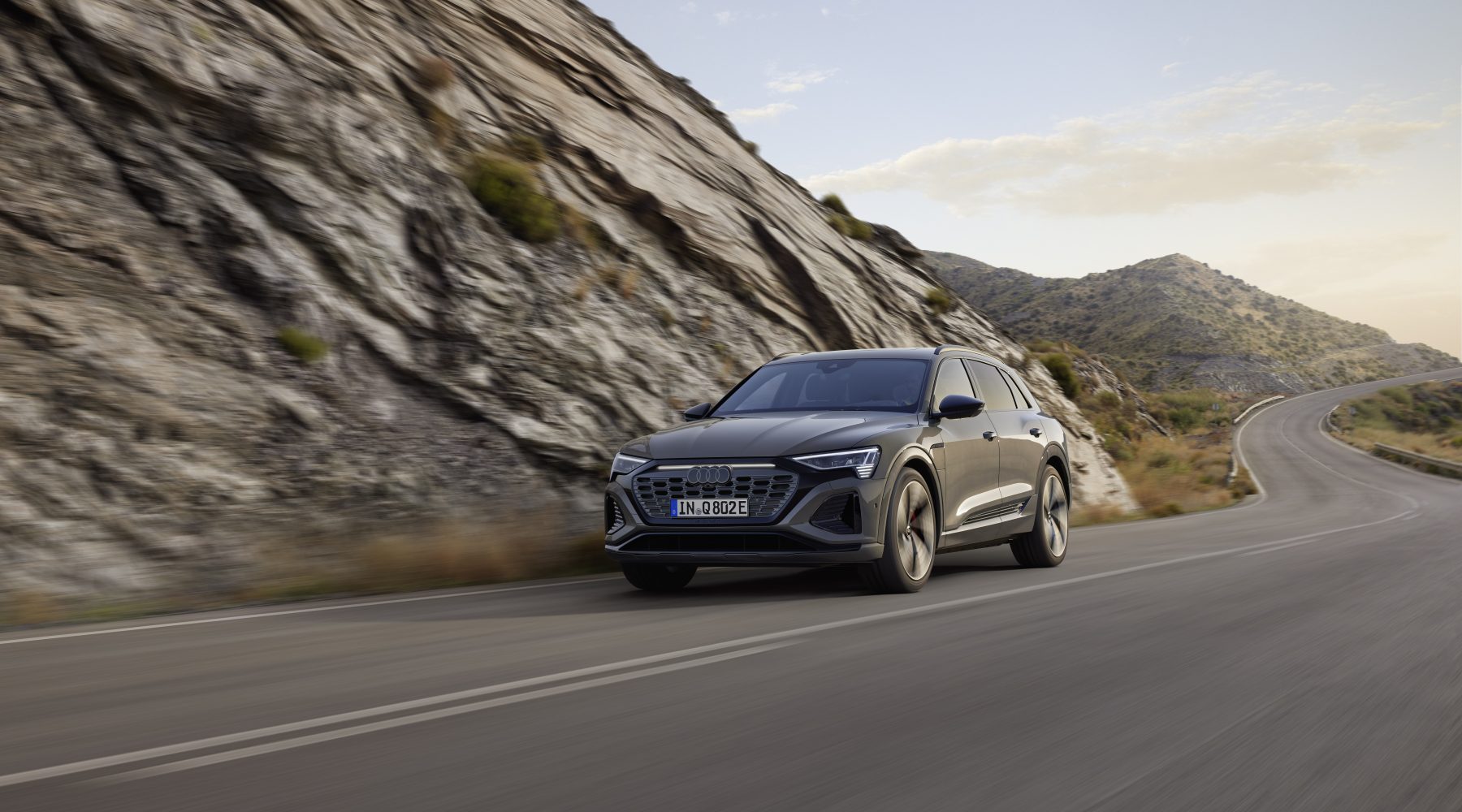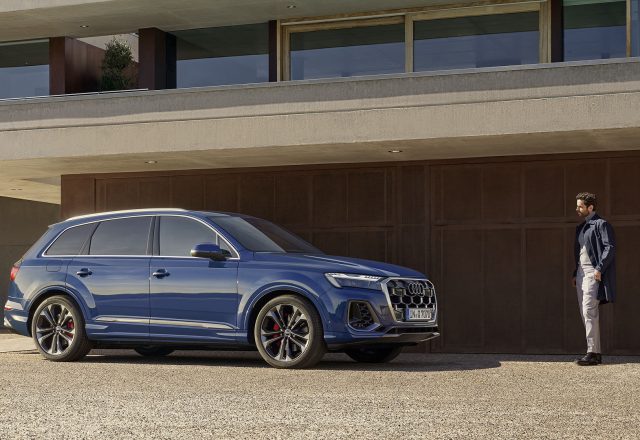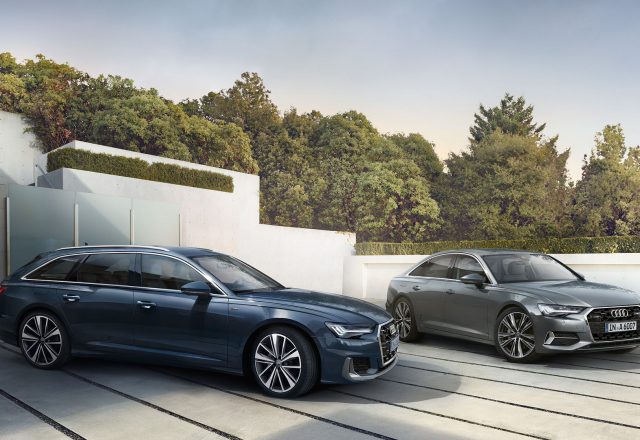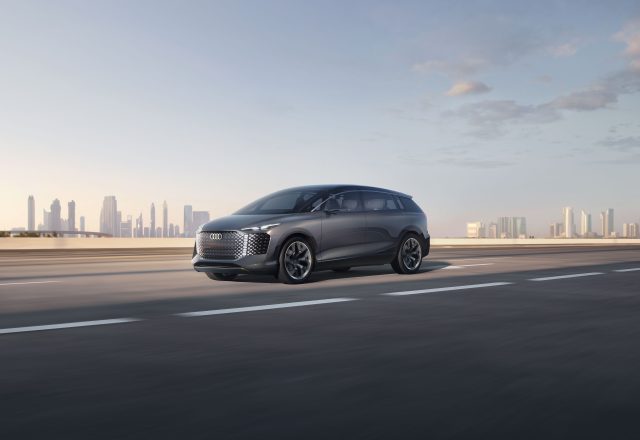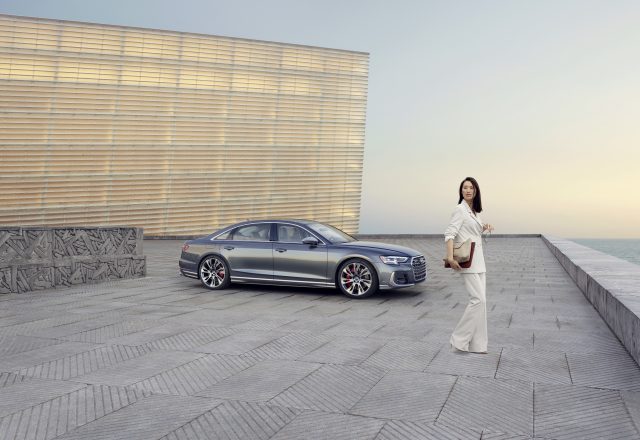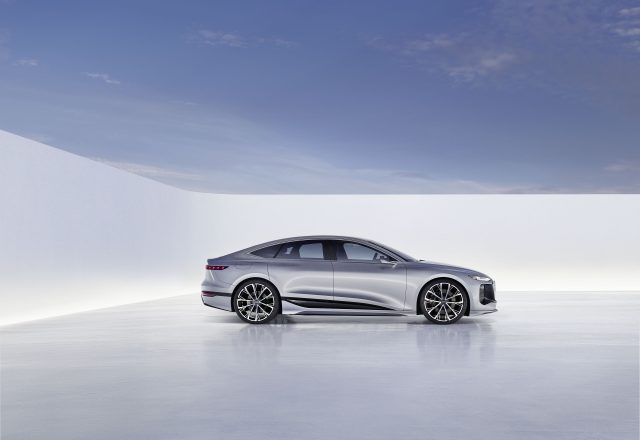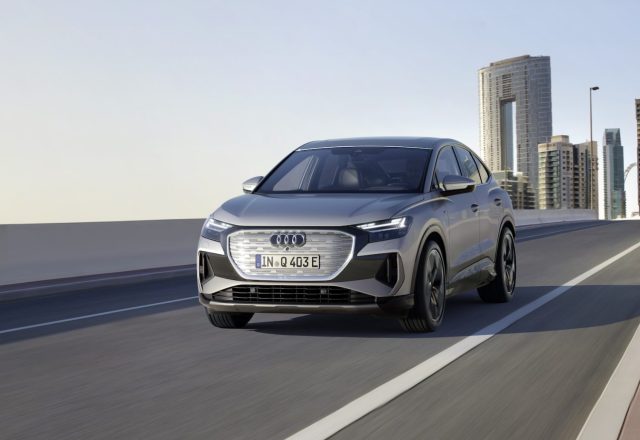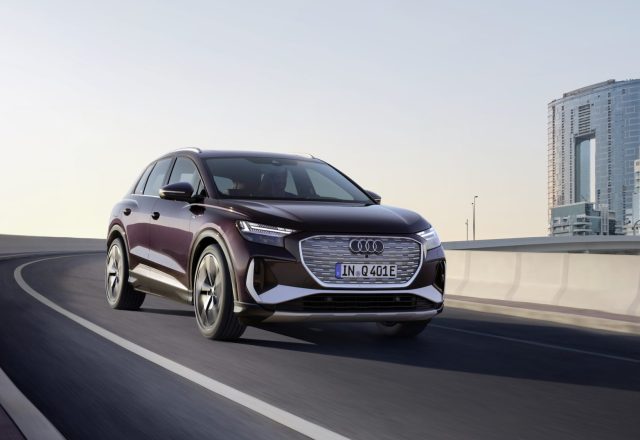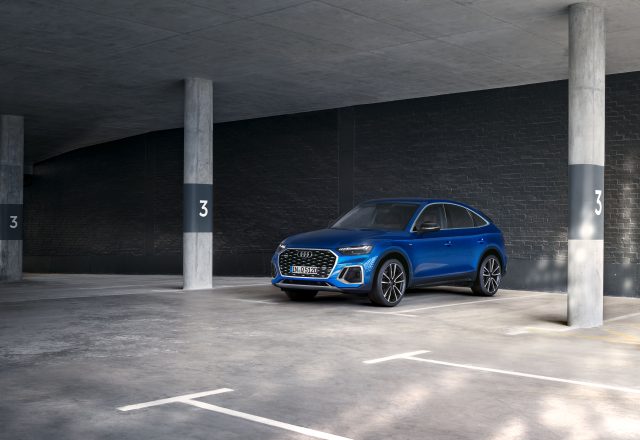It was about four years ago that electric mobility made its way into Audi’s portfolio. The premium manufacturer entered the age of electric mobility back in 2018 with the Audi e-tron – and has since impressed in the segment of electric luxury SUVs. And perhaps also in your fleet?
Your company car drivers have something to look forward to, since the new Audi Q8 e-tron¹⁾ is now building on the success story of the electric pioneer. Audi’s top-of-the-line model in the SUV and Sportback body styles impresses thanks to a new appearance, optimised performance and – compared with the Audi e-tron – a larger battery capacity and higher charging performance. As a result, ranges of up to 582 kilometres with the Audi Q8 55 e-tron (combined power consumption in kWh/100 km: – (NEDC); 24.4–20.6 (WLTP); CO₂ emissions (combined) in g/km: 0. Only consumption and emission values according to WLTP and not according to NEDC are available for the vehicles) and up to 600 km with the Audi Q8 55 Sportback e-tron (combined power consumption in kWh/100 km: – (NEDC); 24.1–19.9 (WLTP); CO₂ emissions (combined) in g/km: 0. Only consumption and emission values according to WLTP and not according to NEDC are available for the vehicles) are now possible (determined according to WLTP in each case).
Electrifying at first glance
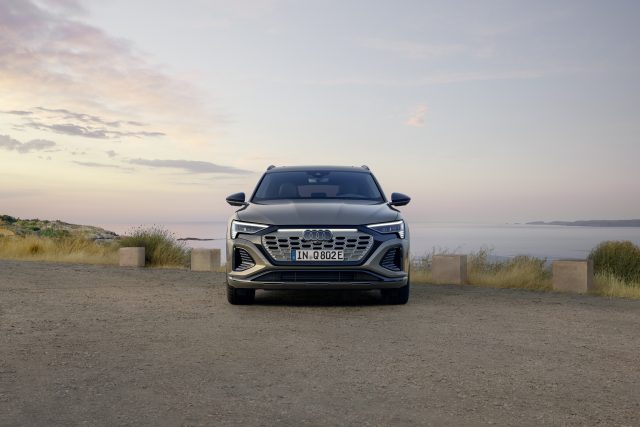
This is thanks to the new front and rear design with the characteristic Singleframe mask, the inverted grille and blade above the redesigned rear diffuser, which systematically carry Audi’s electric design language forward. An exclusive highlight on the edition S line package is the Singleframe grille, which is finished in body colour.
Generous luggage space
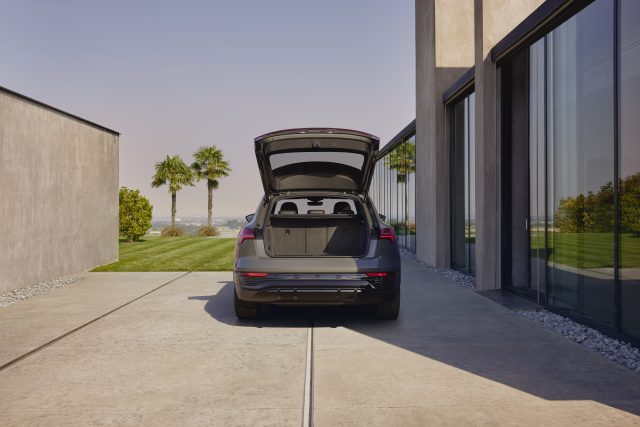
With a vehicle length of 4,915 millimetres, a width of 1,937 millimetres and a height of 1,619 millimetres for the Sportback and 1,633 millimetres for the SUV, the Q8 e-tron¹⁾ offers a large amount of space and comfort. The SQ8 e-tron³⁾ and SQ8 Sportback e-tron⁴⁾ are each two millimetres lower and 39 millimetres wider. Its wheelbase of 2,928 millimetres allows for a lot of legroom in the rear seats too. Both models offer generous storage volume of 569 litres for the SUV and 528 litres for the Sportback. There are also 62 litres available in the front storage area, the so-called “frunk”.
Impressive range
For both body shapes, three drivetrain variants with electric all-wheel drive are available to choose from. During the acceleration process, the base models of the Audi Q8 50 e-tron (combined power consumption in kWh/100 km: – (NEDC); 24.0–20.1 (WLTP); CO₂ emissions (combined) in g/km: 0. Only consumption and emission values according to WLTP and not according to NEDC are available for the vehicles) and Audi Q8 Sportback 50 e-tron (combined power consumption in kWh/100 km: – (NEDC); 23.7–19.5 (WLTP); CO₂ emissions (combined) in g/km: 0. Only consumption and emission values according to WLTP and not according to NEDC are available for the vehicles) generate 250 kW in boost mode and 664 Nm of torque with their two motors, and achieve a range of up to 491 km (SUV) and up to 505 km (Sportback).
During the acceleration process, the base models of the Audi Q8 55 e-tron (power consumption combined in kWh/100 km: – (NEDC); 24.4–20.6 (WLTP); CO₂ emissions (combined) in g/km: 0. Only consumption and emission values according to WLTP and not according to NEDC are available for the vehicles) and the Audi Q8 Sportback 55 e-tron (combined power consumption in kWh/100 km: – (NEDC); 24.1–19.9 (WLTP); CO₂ emissions (combined) in g/km: 0. Only consumption and emission values according to WLTP and not according to NEDC are available for the vehicles) generate 300 kW in boost mode and 664 Nm of torque with their two motors. They achieve ranges of up to 582 km for the SUV and up to 600 km for the Sportback, in accordance with the WLTP. The top speed, like that of the Q8 50 e-tron (combined power consumption in kWh/100 km: – (NEDC); 24.0–20.1 (WLTP); CO₂ emissions (combined) in g/km: 0. Only consumption and emission values according to WLTP and not according to NEDC are available for the vehicles) is limited to 200 km/h.
Convenient motoring
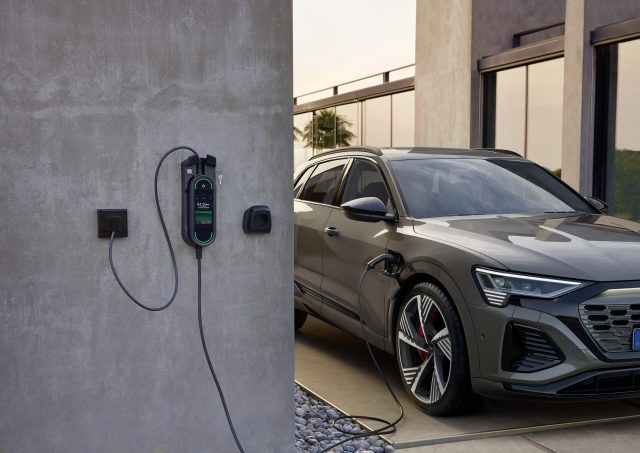
The battery of the Q8 50 e-tron (combined power consumption in kWh/100 km: – (NEDC); 24.0–20.1 (WLTP); CO₂ emissions (combined) in g/km: 0. Only consumption and emission values according to WLTP and not according to NEDC are available for the vehicles) has a storage capacity of 89 net kilowatt hours (max. storage capacity of 95 gross kWh), while the more powerful version of the Q8 55 e-tron (combined power consumption in kWh/100 km: – (NEDC); 24.4–20.6 (WLTP); CO₂ emissions (combined) in g/km: 0. Only consumption and emission values according to WLTP and not according to NEDC are available for the vehicles) accordingly has 106 net kWh (114 gross kWh). Thanks to an adjustment to the battery management system, the net battery capacity usable for customers has increased as well.
At a high-powered charging (HPC) station, the Audi Q8 50 e-tron (power consumption combined in kWh/100 km: – (NEDC); 24.0–20.1 (WLTP); CO₂ emissions (combined) in g/km: 0. Only consumption and emission values according to WLTP and not according to NEDC are available for the vehicles) ereaches a maximum charging performance of 150 kW. With the Q8 55 e-tron (combined power consumption in kWh/100 km: – (NEDC); 24.4–20.6 (WLTP); CO₂ emissions (combined) in g/km: 0. Only consumption and emission values according to WLTP and not according to NEDC are available for the vehicles) the maximum charging performance increases to up to 170 kW. The battery in the Audi Q8 55 e-tron (combined power consumption in kWh/100 km: – (NEDC); 24.4–20.6 (WLTP); CO₂ emissions (combined) in g/km: 0. Only consumption and emission values according to WLTP and not according to NEDC are available for the vehicles) and Audi Q8 Sportback 55 e-tron (combined power consumption in kWh/100 km: – (NEDC); 24.1–19.9 (WLTP); CO₂ emissions (combined) in g/km: 0. Only consumption and emission values according to WLTP and not according to NEDC are available for the vehicles) can be charged from ten to 80 per cent during a roughly 31-minute charging stop⁵⁾ – under ideal conditions, this corresponds to a range of up to 420 kilometres (according to WLTP). At an AC charging station or wall box, the Audi Q8 e-tron charges at up to 11 kW.
The market launch of the new Audi Q8 e-tron¹⁾ und Audi Q8 Sportback e-tron²⁾ is planned for the end of February 2023 in Germany and other significant European markets. Both models have already been available to order since mid-November.
All information applies to the German market. Availability and specifications may vary from country to country. Therefore, it is recommended to check with local sales representatives or dealers before final order.
1)Audi Q8 e-tron combined power consumption in kWh/100 km: – (NEFZ); 24.4–20.1 (WLTP); CO₂ emissions (combined) in g/km: 0. Only consumption and emission values according to WLTP and not according to NEDC are available for the vehicles. Information on fuel/power consumption and CO₂ emissions given in ranges depends on the equipment selected for the vehicle. Vehicle images show special equipment.
²⁾Audi Q8 Sportback e-tron combined power consumption in kWh/100 km: – (NEFZ); 24,1–19,5 (WLTP); CO₂ emissions (combined) in g/km: 0. Only consumption and emission values according to WLTP and not according to NEDC are available for the vehicles. Information on fuel/power consumption and CO₂ emissions given in ranges depends on the equipment selected for the vehicle. Vehicle images show special equipment.
³⁾Audi SQ8 e-tron combined power consumption in kWh/100 km: – (NEFZ); 28,0–24,6 (WLTP); CO₂ emissions (combined) in g/km: 0. Only consumption and emission values according to WLTP and not according to NEDC are available for the vehicles. Information on fuel/power consumption and CO₂ emissions given in ranges depends on the equipment selected for the vehicle. Vehicle images show special equipment.
⁴⁾Audi SQ8 Sportback e-tron combined power consumption in kWh/100 km: – (NEFZ); 27,0–23,5 (WLTP); CO₂ emissions (combined) in g/km: 0. Only consumption and emission values according to WLTP and not according to NEDC are available for the vehicles. Information on fuel/power consumption and CO₂ emissions given in ranges depends on the equipment selected for the vehicle. Vehicle images show special equipment.
⁵⁾Battery charging times may vary depending on various factors such as ambient temperature, use of other country-specific plugs and use of the preconditioning function (e.g. remote vehicle air conditioning). Use of household connectors limits the charging efficiency of the e-tron charging system.
The specified fuel/power consumption and emissions figures were determined according to the measurement procedures prescribed by law. On 1 January 2022, the WLTP test cycle replaced the NEDC test cycle fully. This means that NEDC values will not be provided for new type-approved vehicles after this date. The information does not refer to an individual vehicle and is not an integral part of the offer. It is provided solely for the purpose of comparison between the different vehicle types. Additional equipment and accessories (e.g. add-on parts, different tyre formats etc.) may change the relevant vehicle parameters, such as weight, rolling resistance and aerodynamics, and, in conjunction with weather and traffic conditions and individual driving style, may affect fuel consumption, electrical power consumption, CO2 emissions and the performance figures for the vehicle. Because it involves more realistic testing conditions, the fuel consumption and CO2 emission values calculated in accordance with the WLTP are in many cases higher than those calculated in accordance with the NEDC. As a result, there may be corresponding changes to vehicle taxation starting on 1 September 2018. Further information about the differences between WLTP and NEDC can be found at www.audi.de/wltp
Further information on official fuel consumption figures and the official, specific CO2 emissions of new passenger cars can be found in the “Guide on the fuel economy, CO2 emissions and power consumption of new passenger car models”, which is available free of charge at all sales dealerships and from DAT Deutsche Automobil Treuhand GmbH, Hellmuth-Hirth-Str. 1, 73760 Ostfildern, Germany, or at www.dat.de/co2
Stand: 08.12.2022
© Audi
